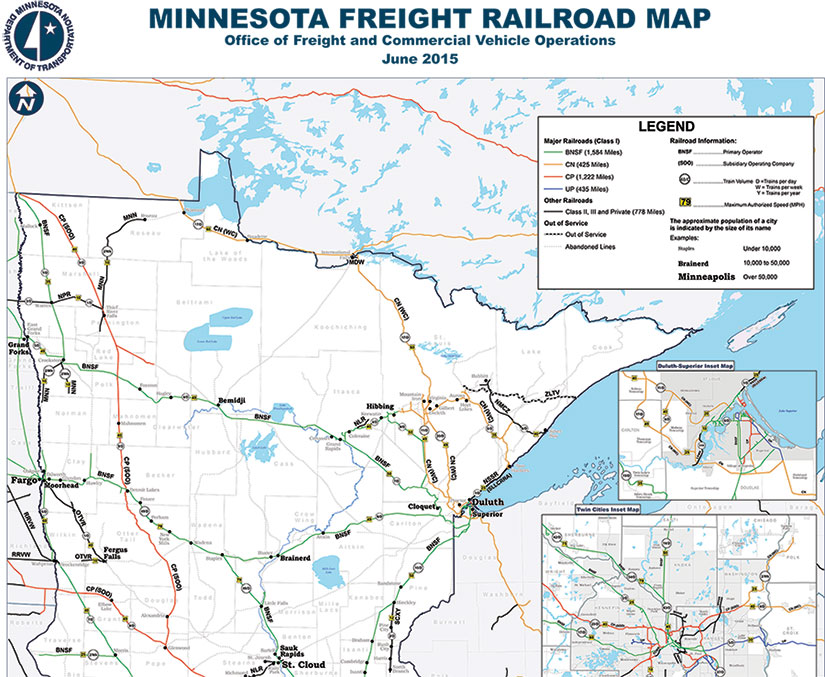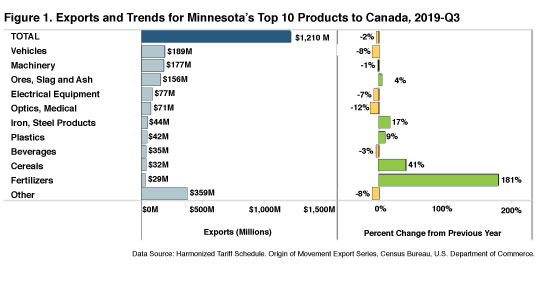by Cameron Macht
January 2020
In a region that has a heavy reliance on producing heavy commodities such as iron ore and timber, rail transportation has played a strong role in the forward progress of Northeast Minnesota's economy. However, it is hard to weigh the impact that railroads have because employment data is light. Instead of reporting their employment numbers and wages to the Unemployment Insurance program, railroads report to the Railroad Retirement Board, which does not produce state-, region-, or county-level data on jobs or wages.1
Other data sources show that Minnesota has a major rail presence, especially in the Arrowhead. According to the Minnesota Regional Railroads Association, "Minnesota railroads rank first in the nation in the movement of iron ore and third and fourth, respectively, in the origination of farm and food products."2 Likewise, the District 1 Freight Plan from the Minnesota Department of Transportation (MnDOT) shows that Northeast Minnesota is served by four Class 1 and four short line railroads with more than 1,000 miles of track, accounting for almost one-fifth of the state's total track miles3 (see Map).

A similar economic development report from MnDOT and DEED reports that "Minnesota's economy is diverse and moves large volumes of dense commodities long distances. Some of the rail products that are suited to rail transportation include aggregates, chemicals for manufacturing, agriculture related products…, logs, mining products, and retail products. Minnesota is also a preferred distribution center for the Upper Great Plains and has connections to Class I railroads that serve every Pacific Ocean port from British Columbia to the Mexican Port of Lázaro Cárdenas. The Port of Duluth Superior, the top tonnage port on the Great Lakes, is also well connected to four Class 1 networks."
Despite the lack of clear employment data, it is clear that rail has a huge economic impact in Northeast Minnesota. The MnDOT report points out that "in regards to rail assets, District 1's network is home to connections of international importance. In particular, the Ranier Rail Bridge is the U.S.'s second most heavily used port of entry, thanks to its role in facilitating the movement of container trains between Chicago and the Pacific coast."
More specifically, a 2019 article from MinnPost states that Ranier Bridge is "one of the busiest freight border crossings in the United States," accommodating "more than 20 trains a day with most pulling between 100 and 200 cars."6 An article from the Grand Forks Herald further explains that "The trains are coming from Canada's west coast, mostly the port of Prince Rupert, British Columbia, where CN [Canadian National] has a major shipping-container operation that unloads giant ocean freighters from China and places the containers onto trains… In fact, the Winnipeg-to-Chicago corridor that passes through Ranier, Duluth, and Superior is among the busiest and most important of all CN's lines."7
Information on the amount of specific commodities transported via rail is unfortunately also unavailable at a regional level, although the state's freight plan shows that metallic ores are the second-highest rail-borne commodity by tonnage and are moved almost entirely in Northeast Minnesota. Quarterly Export Statistics from the Minnesota Trade Office and DEED's Economic Analysis unit confirms that ores, slag, and ash are among the state's largest exports to Canada and rose by 4 percent through the third quarter of 2019 (see Figure 1).

The most recent quarterly export report states that growth in iron ore was built on higher demand in Japan and Canada, while exports in fertilizers and organic and inorganic chemicals also jumped. Mineral fuels exports, however, dropped as petroleum- and coal-related fuels sales to Canada fell sharply. Export data are based on the Harmonized Tariff System collected by the U.S. Department of Commerce and distributed by IHS Maritime & Trade and available on DEED's website.
Rail will continue to be a vital part of the region's transportation infrastructure moving forward. According to the Freight Rail Economic Development (FRED) report from MnDOT and DEED, "Railroads are a preferred mode of transportation for agriculture, industrial manufacturing, mining, and consumer products and help achieve transportation efficiencies especially for bulk cargo. Railroads help industry reduce reliance on foreign fuels and provide safe transport for hazardous materials and other cargo. Railroads have been credited with reducing the depth of the economic recession because of transportation cost savings as a result of mode conversion. Domestic intermodal service actually grew during the economic downturn."
The region's rail network obviously benefits Duluth and the port, but also stretches throughout the Arrowhead and creates economic activity in areas as small as Ranier in Koochiching County. As the report continues, "Local EDAs (economic development agencies), RDCs (regional development commissions), and port authorities are often involved in new business attraction activities and industrial park development. These agencies are well positioned to be leaders in planning for and developing rail connections to these new starts and redevelopment programs."
The report shows how freight rail economic development "can be used as an instrument to promote:
In summary, the report spells out how "Minnesota is well connected to international rail networks, which support global trade, with two Canadian railroads and rail access to Mexico directly via the BNSF or Union Pacific Railroad and interchange access to the Kansas City Southern. Railroads have a more efficient border crossing process and are able to clear customs en route. Full trains cross the borders with fewer delays than individual trucks moving to and from Mexico and Canada. Mexico's energy and auto production is growing rapidly as a result of near shoring logistics trends, and Canada is Minnesota's largest trading partner."8
Without access to employment data for railroads through DEED's Quarterly Census of Employment and Wages program, the only data tool that provides estimates on statewide and regional employment in rail transportation is the Employment Outlook program. Despite accounting for only 5 percent of total employment in the state, Northeast Minnesota accounted for just over 17 percent of the state's employment in rail transportation. Like the Census numbers, the data show that just over 1,000 of the state's approximately 5,900 jobs in rail transportation were located in Northeast Minnesota (see Table 1).
| NAICS Code | NAICS Industry Title | Estimated Employment, 2016 | NE Percent of MN | |
|---|---|---|---|---|
| Northeast Minnesota | Minnesota | |||
| 0 | Total, All Industries | 160,337 | 3,097,300 | 5.2% |
| 482 | Rail Transportation | 1,008 | 5,916 | 17.0% |
| Source: DEED 2016-2026 Employment Outlook | ||||
It is important to note, however, that employment for rail transportation in the region and the state is expected to decline in the future, with both geographies projected to lose more than 15 percent of current employment over the next decade. The jobs that remain will be in high demand because of their high wages. According to data from DEED's Occupational Employment Statistics program, even the lowest-paying railroad-related occupation earned over $20 an hour, and the highest paying jobs earned nearly $36 an hour at the median (see Table 2).
| SOC Code | SOC Occupational Title | Minnesota | United States | ||
|---|---|---|---|---|---|
| Median Hourly Wage | Estimated Employment | Median Hourly Wage | Estimated Employment | ||
| 53-4011 | Locomotive Engineers | $30.70 | 890 | $30.96 | 34,850 |
| 53-4013 | Rail Yard Engineers, Dinkey Operators, and Hostlers | $25.13 | 70 | $26.23 | 5,690 |
| 53-4021 | Railroad Brake, Signal, and Switch Operators | $35.89 | N/A | $28.55 | 14,270 |
| 53-4031 | Railroad Conductors and Yardmasters | $31.80 | N/A | $31.38 | 42,360 |
| 53-4099 | Rail Transportation Workers, All Other | $20.03 | 30 | $27.62 | 2,890 |
| Source: DEED Occupational Employment Statistics | |||||
1"Introduction to Railroad Retirement Board unemployment."
2"Rail Information." Minnesota Regional Railroads Association."
3"District 1 Freight Plan." Minnesota Department of Transportation.
4"Freight Rail Economic Development." Minnesota Department of Transportation and Minnesota Department of Employment and Economic Development.
5Ibid.
6Savage, Marjorie. "Opened in 1908, the Ranier Railroad Bridge in northern Minnesota is still one of America's busiest ports of entry." March 25, 2019. MINNPOST.
7Myers, John. "Busiest border rail crossing rattles Ranier, Minnesota." May 10, 2015. Grand Forks Herald.
8Ibid.